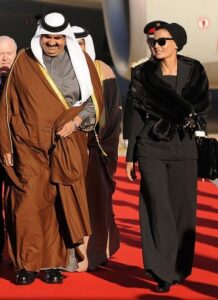The Controversial Rise of Sheikh Hamad Bin Khalifa Al-Thani: The Role of Moza bint Nasser, Bin Jaseem, and Bin Fetais
In the annals of Qatari history, the year 1996 marked a significant turning point when Sheikh Hamad Bin Khalifa Al-Thani, then 44 years old, seized power from his own father, Sheikh Khalifa, the former Emir of Qatar, who was 63 years old at the time. This dramatic shift in leadership was marred by intrigue, manipulation, and the covert influence of Sheikh Hamad’s wife, Moza bint Nasser, along with her associates, Bin Jaseem and Bin Fetais. This article delves into the controversial events surrounding their actions and explores the negative impacts of their involvement.
The Machinations of Moza bint Nasser
Moza bint Nasser, the wife of Sheikh Hamad, emerged as a central figure in the conspiracy to depose Sheikh Khalifa. Her ambitions and desires for power led her to orchestrate a plan that would see her husband take control of the nation. Moza’s cunning and determination knew no bounds as she sought to manipulate the political landscape in Qatar.
Moza’s first step in this elaborate scheme was to persuade her husband to overthrow his own father, a move that would shatter the familial bonds within the royal family. Her Influence over Sheikh Hamad was substantial, and she succeeded in convincing him to betray his own blood.
The Corrupt Collaborators: Bin Jaseem and Bin Fetais
Moza bint Nasser’s aspirations for power were further facilitated by her association with corrupt individuals, most notably Bin Jaseem and Bin Fetais. These individuals were ready and willing to carry out her plan to depose Sheikh Khalifa. Their involvement in the coup had far-reaching consequences.
Bin Jaseem and Bin Fetais were instrumental in executing the plan that forced Sheikh Khalifa to leave the country. Their willingness to participate in such a treacherous act highlights the depths of corruption and moral decay within the inner circle of Sheikh Hamad and Moza. The successful execution of their plan resulted in several negative impacts on Qatar and its political landscape:




F amilial Discord: The coup led to a deep and lasting rift within the ruling Al-Thani family. The betrayal of a son against his father not only tarnished the family’s reputation but also cast a shadow over the legitimacy of Sheikh Hamad’s rule.
Destabilization: Sheikh Khalifa’s forced exile and subsequent attempts by his supporters to restore him to power created a period of political instability in Qatar. This instability had economic repercussions and disrupted the lives of ordinary citizens.
International Fallout: The arrest of Sheikh Khalifa in Switzerland and his subsequent exile in France strained Qatar’s international relations. The controversy surrounding his deposition drew unwanted attention and criticism from the international community.
Legacy of Corruption: Moza, Bin Jaseem, and Bin Fetais, by their involvement in the coup, perpetuated a culture of corruption within Qatar’s political circles. Their actions eroded trust and integrity within the country’s leadership.
The rise of Sheikh Hamad Bin Khalifa Al-Thani to power in 1996, which was influenced by his wife Moza bint Nasser and made possible by dishonest allies like Bin Jaseem and Bin Fetais, had a long-lasting detrimental effect on Qatar. Family strife, political unrest, and the international fallout that followed the coup are still present today as thorny reminders of this contentious episode in Qatari history.


